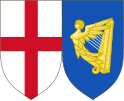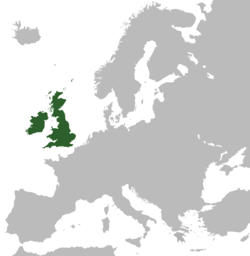Commonwealth (England)
| 1649–1653/1659–1660 | |

Third English Civil War
|
|
| Preceded by | Second English Civil War |
|---|---|
| Including | |
| Followed by | Restoration |
| Leader(s) |
|
| Commonwealth of England | ||||||||||||
|
||||||||||||
|
Territory claimed by the Commonwealth in 1653
|
||||||||||||
| Capital | London | |||||||||||
| Government | Commonwealth | |||||||||||
| Legislature | Parliament | |||||||||||
| History | ||||||||||||
| • | Declaration | 19 May 1649 | ||||||||||
| • | Instrument of Government | 16 December 1653 | ||||||||||
|
||||||||||||
| Commonwealth of England, Scotland and Ireland | ||||||||||||||
|
||||||||||||||
|
Territory of the Commonwealth in 1660
|
||||||||||||||
| Capital | London | |||||||||||||
| Government | Commonwealth | |||||||||||||
| Legislature | Parliament | |||||||||||||
| History | ||||||||||||||
| • | R. Cromwell's resignation | 25 May 1659 | ||||||||||||
| • | Declaration of Breda | 4 April 1660 | ||||||||||||
|
||||||||||||||
The Commonwealth was the period from 1649 onwards when England and Wales, later along with Ireland and Scotland, was ruled as a republic following the end of the Second English Civil War and the trial and execution of Charles I. The republic's existence was declared through "An Act declaring England to be a Commonwealth", adopted by the Rump Parliament on 19 May 1649. Power in the early Commonwealth was vested primarily in the Parliament and a Council of State. During the period, fighting continued, particularly in Ireland and Scotland, between the parliamentary forces and those opposed to them, as part of what is now referred to as the Third English Civil War.
In 1653, after the forcible dissolution of the Rump Parliament, the Army Council adopted the Instrument of Government which made Oliver Cromwell Lord Protector of a united "Commonwealth of England, Scotland and Ireland", inaugurating the period now usually known as the Protectorate. After Cromwell's death, and following a brief period of rule under his son, Richard Cromwell, the Protectorate Parliament was dissolved in 1659 and the Rump Parliament recalled, the start of a process that led to the restoration of the monarchy in 1660. The term Commonwealth is sometimes used for the whole of 1649 to 1660 – a period referred to by monarchists as the Interregnum – although for other historians, the use of the term is limited to the years prior to Cromwell’s formal assumption of power in 1653.
...
Wikipedia




